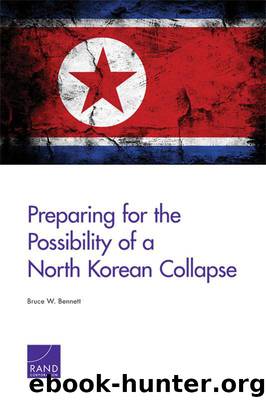Preparing for the Possibility of a North Korean Collapse by Bruce W. Bennett

Author:Bruce W. Bennett
Language: eng
Format: mobi
ISBN: 9780833081742
Publisher: RAND Corporation
Published: 2013-04-19T16:00:00+00:00
Strategies for Providing for North Korean Welfare Through Humanitarian Aid
In providing humanitarian aid, a ROK and U.S. intervention should strive to keep people in their homes, jobs, and normal day-to-day environment. Once people leave their homes and jobs, their humanitarian needs grow significantly (for shelter, clothing, cooking implements, water, etc.), and their ability to become self-sufficient over time is greatly impeded. Moreover, if many North Koreans become refugees, entering the ROK or China to obtain food and good jobs, they could overwhelm the ability of both countries to absorb immigrants, flood their job markets with vast numbers of low-skilled laborers, raise opposition in China and the ROK against these immigrants who would be perceived as “stealing” jobs and other resources from the local population, and politically destabilize at least the border areas. Indeed, because China does not want any of these refugees crossing into China, China may be forced to intervene deeply into North Korea (at least 100 km or so to create refugee camps and barriers to stem the flow of refugees). The ROK and the United States will want to strive to avoid the development of situations that would press China into such an intervention or to minimize the Chinese perception of the need to hold substantial parts of the North Korean territory if it does decide to intervene.
Figure 5.3 provides a frame of reference for doing so. This figure shows aggregated locations for the civilian population based on the 2008 North Korean census. Some 3.3 million North Koreans live in the coastal counties of the northeast, while 6 million live in the interior counties north of Pyongyang.6 Considering the territory slices moving north from the DMZ, relatively few North Korean civilians live south of Pyongyang (not quite 4 million: 1.1 plus 2.3 plus 0.5 million), a good number live in the Pyongyang slice (about 8 million: 1.4 plus 5.8 plus 0.7 million), and nearly half of the population lives in the slice north of Pyongyang (about 11 million: 1.8 plus 6.0 plus 3.3 million). The last group would likely be most affected by a famine because the most productive farming area of North Korea is south of Pyongyang. Alternatively, about 4.3 million North Koreans live in the coastal counties on the west coast, and about 4.5 million live in the coastal counties on the east coast, or almost 9 million civilians in the coastal counties.
Figure 5.3
Providing Humanitarian Aid: Geographic Requirements
Download
This site does not store any files on its server. We only index and link to content provided by other sites. Please contact the content providers to delete copyright contents if any and email us, we'll remove relevant links or contents immediately.
| Arms Control | Diplomacy |
| Security | Trades & Tariffs |
| Treaties | African |
| Asian | Australian & Oceanian |
| Canadian | Caribbean & Latin American |
| European | Middle Eastern |
| Russian & Former Soviet Union |
The Secret History by Donna Tartt(16664)
The Social Justice Warrior Handbook by Lisa De Pasquale(11495)
Thirteen Reasons Why by Jay Asher(7803)
This Is How You Lose Her by Junot Diaz(5800)
Weapons of Math Destruction by Cathy O'Neil(5049)
Zero to One by Peter Thiel(4837)
The Myth of the Strong Leader by Archie Brown(4796)
Promise Me, Dad by Joe Biden(4459)
Beartown by Fredrik Backman(4435)
Stone's Rules by Roger Stone(4423)
How Democracies Die by Steven Levitsky & Daniel Ziblatt(4417)
The Fire Next Time by James Baldwin(4352)
100 Deadly Skills by Clint Emerson(4089)
A Higher Loyalty: Truth, Lies, and Leadership by James Comey(4041)
Rise and Kill First by Ronen Bergman(4025)
The David Icke Guide to the Global Conspiracy (and how to end it) by David Icke(3895)
The Farm by Tom Rob Smith(3880)
Secrecy World by Jake Bernstein(3790)
The Doomsday Machine by Daniel Ellsberg(3740)
